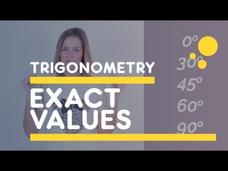ABCMouse
The Itsy Bitsy Spider
Out came the sun and — then what? A captivating music video adds western flair to the ever-favorite children's song, "The Itsy Bitsy Spider."
Physics Girl
How to Make a Hurricane on a Bubble
Pop! Does your class know that bubbles help us understand our planet, molecular structure, and more? The video teaches how to create colorful vortices on a bubble using basic equipment. Then it explains other interesting ways scientists...
FuseSchool
Exact Trig Values - Easy Table
Having trouble remembering the trig ratios of common angles? This resource may be the solution! Using a table, the video instructor describes a memorable pattern. Scholars have an opportunity to practice the pattern during the video.
FuseSchool
Transport in Plants, Part 3: Phloem and Translocation
Leaves produce sugars through photosynthesis, but how do the sugars get to the rest of the plant? The final video in a three-part series within the Fuse School Biology playlist answers this question. It details how the phloem and...
FuseSchool
Transport in Plants, Part 1: Xylem and Phloem
Humans use their hearts and circulatory systems to move things through their bodies, but plants also have a transport system. The first video in a three-part series introduces the xylem and phloem. It explains what each part moves, which...
Physics Girl
How to Control Light with Water
Can you bend light waves using water? Physics Girl demonstrates this phenomenon and explains how it happens as part of her larger series. She then details the applications and even explains how the Internet works.
Be Smart
How Does A Canyon Become Grand?
Ah, the Grand Canyon ... ain't it grand? The narrator of a video from PBS Digital Studios explains, in detail, how the Grand Canyon was formed over millions of years.
Be Smart
%$?# Allergies!
About 40,000 people have sinus surgery every year, hoping to relieve sinus congestion due to allergies. Learners see why some people have allergies and others don't. From flowers' pollen to pet dander, some human immune systems are...
FuseSchool
Quadratic Graph—Roots and Y-Intercept
Build a connection between the equation and graph of a quadratic function. A thorough video lesson demonstrates how to use find the roots and y-intercept of a quadratic function and create a graph from the three points. The instructor...
FuseSchool
Finding the Equation of a Line Through 2 Points: Part 1
Demonstrate how to write a linear equation knowing only two points that it passes through. A straightforward video lesson introduces the gradient (or slope) formula to begin writing the equation. Then, using substitution, viewers find...
FuseSchool
Reciprocal Graphs
Explore the patterns of a reciprocal function with an engaging video lesson that compares graphs of reciprocal functions to different polynomial functions. After describing the key features, the instructor explains the patterns that...
FuseSchool
Calculator Trick—Table of Values
Work smarter, not harder! Learn a function of the calculator that assists with creating a table of values. The calculator does the work of substituting values and finding the input-output pairs.
FuseSchool
Finding the Gradient of a Straight Line
Investigate the relationship between the gradient, or slope, of a line and its graph. Pupils learn to use a graph to calculate the slope of a line. The video lesson includes both positive and negative slopes and compares the steepness of...
FuseSchool
Rationalising the Denominator
Take the next step in simplifying radical expressions. The video shows how to rationalize the denominator that contains square roots. Examples contain simple radicals and ones that require using conjugates.
FuseSchool
Completing the Square—Plotting Quadratics
Where is the turning point? The presentation demonstrates how the process of completing the square finds several points in the graph of a quadratic. One of the most important points found is the vertex of the graph. The video shows where...
PBS
When Did the First Flower Bloom?
Were the first flowers made in China? The first evidence of a flower, discovered in current-day China, changes the story of life on Earth. A short video details the evolution of flowers. It highlights the co-evolution of animals and...
Physics Girl
Which Tank Fills First?
Can your class solve the riddle? A video from the Physics Girl playlist tackles the puzzle of Pascal's Principle. Viewers observe as a series of connected tanks fill up and try to guess which will fill first. The narrator shows the...
Amoeba Sisters
Homeostasis and Negative/Positive Feedback
We all need a little feedback, both positive and negative! Take on one of the trickier Biology 1 concepts using a thoughtfully worded video from a fantastic biology playlist. The narrator explains both types of feedback with plenty of...
Be Smart
What's The Loudest Possible Sound?
If a tree falls in the forest and no person is around, does it still make a sound? Students view a short video segment to determine sound and decibel levels of various objects, including the loudest and quietest possible sounds humans...
FuseSchool
SOHCAHTOA - Finding Missing Angles
Apply the trig ratios to find unknown angle measures. Learners review the side and angle relationships in right triangles and then apply the ratios to find the angle measures. The video shows several worked-out examples applying all...
Numberphile
Pi and Bouncing Balls
Don't drop the ball—use a unique resource to teach your class even more about pi! Given a situation about balls bouncing off each other, viewers see how many bounces it takes for the larger ball to move in the other direction. This...
FuseSchool
Punnett Squares
Mendel discovered that you inherit each gene from either parent, but not both. The video, part of a playlist on Genetics from Fuse School, explains how this applies to solving Punnett squares. It walks through the process of solving and...
Crash Course
The Language of Film
New ventures and new technologies require new ways of referring to things. In stepped Edwin S. Porter, whose films Life of an American Fireman and The Great Train Robbery used parallel action and cross-cutting to develop his...
Crash Course
The Golden Age of Hollywood
Did movies save America during the Great Depression? Or did the Great Depression save movies? Learn more about the Golden Age of Hollywood with a video that covers the five major film studios, the colorization of big budget movies, and...

























